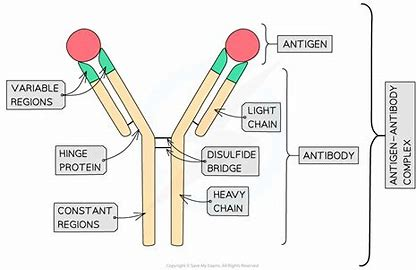1. Antigens + The immune response
1/19
There's no tags or description
Looks like no tags are added yet.
Name | Mastery | Learn | Test | Matching | Spaced |
|---|
No study sessions yet.
20 Terms
Antigens
Molecules that can generate an immune response when detected by the body
foreign antigens
Antigens that aren’t normally found in the body
Pathogen
An organism that causes disease e.g. bacteria, viruses and fungi
Cancerous or pathogen infected cells have abnormal antigens on their surface, which trigger an immune response.
Cancerous or pathogen infected cells have abnormal antigens on their surface, which trigger an immune response.
Toxins
These are poisons and they are molecules, not cells
Phagocyte
A type of white blood cell that carries out phagocytosis/ engulfment of pathogens.
T-Cell
A type of white blood cell. It’s receptor protein binds to the antigen of the pathogen which activates the T-Cell itself.
T helper cells
release chemical signals that activate and stimulate phagocytes, cytotoxic T-Cells and B cells.
cytotoxic T-Cells
Kill abnormal and foreign cells.
B-Cells
A white blood cell which is covered in antibodies. These antibodies bind to antigens to form an antigen-antibody complex.
Each B cell has a different shaped antigen.
Name the 3 main stages of the immune response:
Phagocytosis
T-Cells
B-Cells
Antibody production
Phagocytosis
A phagocyte recognises the foreign antigen on a pathogen.
The cytoplasm of the phagocyte moves round the pathogen engulfing it.
The pathogen is now contained in a phagocytic vacuole in the cytoplasm.
A lysosome fuses with the phagocytic vacuole. The lysozymes break down the pathogen.
The phagocyte then presents the pathogen’s antigens - it sticks the antigen on its surface to activate the immune system cells. The phagocyte becomes an antigen-presenting cell.
T-Cells
T-Cells bind to the antigens of the pathogen using it’s receptor proteins and activates itself.
They then activate T helper cells, Cytotoxic T-Cells, Phagocytes and B-Cells
B-Cells
When the antibody on the surface of the B-Cell meets a complementary shaped antigen, it binds to it.
This, together with the chemicals released from helper T-Cells, activates the B-cell.
This process is called clonal selection which activates the B-Cells divides into plasma cells.
Antibody production
Plasma cells secrete loads of antibodies specific to the antigen called monoclonal antibodies.
they bind to the surface of the pathogen to form lots of antigen-antibody complexes.
Antibody has 2 active sites, and so can bond to 2 pathogens at the same time, which can clump them together. This process is called agglutination, which destroys the pathogens.
Draw and label an antigen:
Variable regions - Provide the specificity of the antibody as it is different for every type of antibody.
Constant region - Is the same for every human antibody.

Cellulor response
The T-Cells and other immune system cells that they interact with e.g. phagocytes, form the cellular response.
Humoral response
B-Cells, clonal selection and the production of monoclonal antibodies form the humoral response.
Primary response
When a pathogen enters the body for the first time, it activates the immune system in order for antibodies specific to the antigen of the pathogen to be made and also B-Memory cells.
This take time.
Secondary response
If the same pathogen enters the body again, the immune system will produce a quicker and stronger immune response.
Clonal selection happens faster, memory b-cells are activated and divide into plasma cells that produce the right antibody to the antigen.